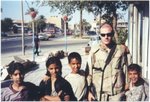Propaganda was a critical element of the Nazis’ rise to power. Without the emotional aspect of the Nazi campaign, either working crowds into a tizzy of emotional hysteria or just tweaking a person’s psyche as he/she noticed a stark placard while walking down the street, the success of the Nazi party would have been much less extreme if not for the efficient use of propaganda.
The German consciousness was acutely aware of the depravity which daily surrounded it. Prior to The Great War Germany had been a powerhouse; strong, respected, competitive. With the armistice came humiliation on a national scale. Hunger, unemployment, crime, and disease were all rampant and the German consciousness weakened perpetually to an unseen power of disgrace. From the very beginning of his campaign to power, Adolph Hitler seized the advantage over his opponents by preying unceasingly on the humiliation which the whole of Germany felt. Whether truthful or not, Hitler’s slogans, speeches, posters, etc., all gripped at the disgrace which so thoroughly burdened the hearts and souls of the population. His entire focus in his battle for power was to exploit the weakened state of the people to sway them in his favor.
Every aspect of the campaign reeked of emotional manipulation. In his early statements regarding the use of propaganda, Hitler stressed the use of emotional manipulative measures to mold the views of the masses. He repeatedly stressed the importance of aiming propaganda at the masses for he certainly understood that the root of power was held by the majority.
Propaganda was interwoven throughout the whole of Hitler’s campaign. When the SA appeared in public, Hitler ordered that they appear in close formation, marching in cadence, giving the appearance of strength. His use of the SA as propaganda was to demonstrate to the people the contrast between the sickly status quo and the promise of progress and strength via Nazi empowerment. The discussion was made that a person can’t help but feel a sense of pride and vigor when one sees a strong, militaryesque unit marching boldly, cohesively, in unison up a thoroughfare. Repeatedly images of strength and force appeared in Nazi propaganda. Posters reflected men in uniform with strong, square jaws, narrow, focused eyes, and stern directed stares. Banners displayed fists gripped tightly around swords, showing still further signs of strength and force. Declarations of “Will of the People,” “Save the German Family,” “We are strong and will get stronger,” etc., all reached to the core of the German psyche to mold the thinking of that generation.
Another aspect of Nazi propaganda was the use of colors and contrasts to manipulate the subconscious. Hitler ordered the use of propaganda posters which sharply contrasted with those of the opposition in order to draw the public’s attention away from the opposition and toward the Nazis. The colors of red, black and white are as sharply contrasting colors as are at an artist’s disposal and the Nazis used the combination regularly in order to convey striking images, slogans, and representations to the German public in a strong and forceful manner. The Nazi banner of a black swastika in a white disk on a red background is the most evident use of the triad and even today it evokes strong emotion in nearly every individual who understands its meaning.
Action of major players was another keenly utilized form of propaganda for Hitler and the Nazis. Hitler boarded a plane in his trips across Germany in an effort to show the public the difference between the forward looking Nazi party and the backward slogging status quo. At the time commercial air travel was virtually unheard of and Hitler used this new object in an effort to demonstrate to the public what they could expect from this progressive revolutionary, as opposed to the routine ventures, methods and maneuvers of the then present administration.
The Nazis appealed to German voters because they drew new lines for political campaigning and made it known that Germany would never again be the world’s whipping boy if they were brought to power. The party hypnotized the public with images of strength, courage, fearlessness, and forcefulness in a period when society was experiencing humiliation, poverty, and helplessness. The Nazis used propaganda and emotional manipulation to Pied-pipe the German public into unquestionable popular support for Nazi ideas and philosophies.
Monday, January 22, 2007
Subscribe to:
Post Comments (Atom)


1 comment:
Your blog keeps getting better and better! Your older articles are not as good as newer ones you have a lot more creativity and originality now keep it up!
Post a Comment